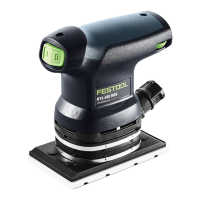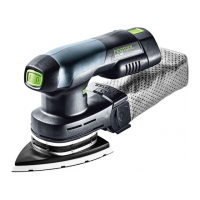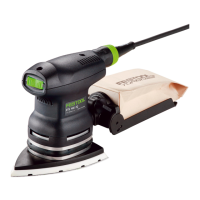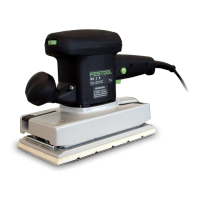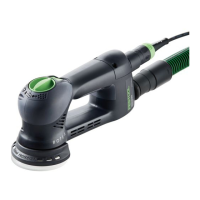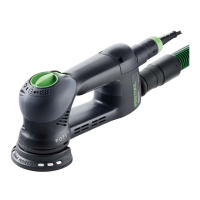6
Schwingschleifer
Technische Daten RTS 400 Q RTS 400 EQ
Leistung
200 W
Leerlaufdrehzahl 14.000 min
-1
5.000 - 14.000 min
-1
Arbeitshübe 28.000 min
-1
10.000 - 28.000 min
-1
Schleifhub 2,0 mm
Schleifschuh 80 x 130 mm
Gewicht 1,1 kg (ohne Kabel)
Schutzklasse / II
und auf akkubetriebene Elektrowerkzeuge (ohne
Netzkabel).
2.2
Maschinenspezifi sche Sicherheitshinweise
- Tragen Sie, wegen den beim Schleifen auftreten-
den Gefahren, stets eine Schutzbrille.
- Entstehen beim Schleifen explosive oder selbst-
entzündliche Stäube, so sind unbedingt die Be-
arbeitungshinweise des Werkstoffherstellers zu
beachten.
- Beim Arbeiten können schädliche/giftige Stäube
entstehen (z. B. bleihaltiger Anstrich, einige Holz-
arten und Metall). Das Berühren oder Einatmen
dieser Stäube kann für die Bedienperson oder
in der Nähe befi ndliche Personen eine Gefähr-
dung darstellen. Beachten Sie die in Ihrem Land
gültigen Sicherheitsvorschriften. Schließen Sie
das Elektrowerkzeug an eine geeignete Absaug-
einrichtung an. Tragen Sie zum Schutz Ihrer
Gesundheit eine P2-Atemschutzmaske.
2.3 Emissionswerte
Die nach EN 60745 ermittelten Werte betragen
typischerweise:
Schalldruckpegel 70 dB(A)
Schallleistungspegel 81 dB(A)
Messunsicherheitszuschlag K = 3 dB
Gehörschutz tragen!
Schwingungsgesamtwerte (Vektorsumme dreier
Richtungen) ermittelt entsprechend EN 60745:
Schwingungsemissionswert
(3-achsig) a
h
= 4,0 m/s
2
Unsicherheit K = 2,0 m/s²
Die angegebenen Emissionswerte (Vibration,
Geräusch)
– dienen dem Maschinenvergleich,
– eignen sich auch für eine vorläufi ge Einschät-
zung der Vibrations- und Geräuschbelastung
beim Einsatz,
– repräsentieren die hauptsächlichen Anwen-
dungen des Elektrowerkzeugs.
Die angegebenen Abbildungen befi nden sich am
Anfang der Bedienungsanleitung.
Symbole
Warnung vor allgemeiner Gefahr
Gehörschutz tragen!
Anleitung/Hinweise lesen!
1 Bestimmungsgemäße Verwendung
Die Maschine ist bestimmungsgemäß vorgesehen
zum Schleifen von Holz, Kunststoff, Stein, Verbund-
werkstoffen, Farbe/Lacke, Spachtelmasse und
ähnlichen Werkstoffen. Metall und asbesthaltige
Werkstoffe dürfen nicht bearbeitet werden.
Aufgrund ihrer Größe, ihres Gewichtes und ihrer
Leistung, ist die Maschine insbesondere zur Be-
arbeitung kleiner Flächen sowie für Überkopfar-
beiten geeignet.
Wegen der elektrischen Sicherheit darf die Ma-
schine nicht feucht sein und nicht in feuchter
Umgebung betrieben werden. Die Maschine darf
nur für Trockenschliff verwendet werden.
Für Schäden und Unfälle bei nicht be-
stimmungsgemäßem Gebrauch haftet der
Benutzer.
2 Sicherheitshinweise
2.1 Allgemeine Sicherheitshinweise
Warnung! Lesen Sie sämtliche Sicher-
heitshinweise und Anweisungen. Fehler
bei der Einhaltung der Warnhinweise und Anwei-
sungen können elektrischen Schlag, Brand und/
oder schwere Verletzungen verursachen.
Bewahren Sie alle Sicherheitshinweise und An-
weisungen für die Zukunft auf.
Der in den Sicherheitshinweisen verwendete
Begriff „Elektrowerkzeug“ bezieht sich auf netz-
betriebene Elektrowerkzeuge (mit Netzkabel)
